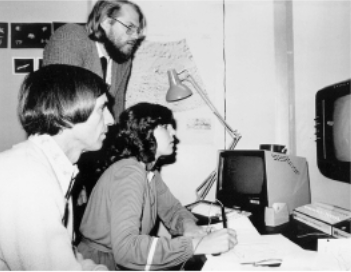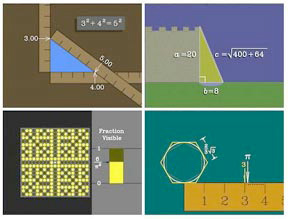Chapter 4: Basic and applied research moves the industry
4.6 JPL and National Research Council of Canada

Jet Propulsion Lab (JPL)

Bob Holzman established the JPL CG Lab at the Jet Propulsion Lab in 1977. Working with Ivan Sutherland, who had moved from the University of Utah to Cal Tech, Holzman envisioned a group with technology expertise for the purpose of visualizing data being returned from NASA missions. Sutherland recommended a graduate student at Utah named Jim Blinn, whose name has become synonymous with JPL and with graphics in general. (Sutherland once allegedly commented that “There are about a dozen really great computer graphics people, and Jim Blinn is six of them.”) Several other notable graphics people worked at JPL, including Alvy Ray Smith, Pat Cole, and Julian Gomez.
Blinn received his bachelor’s degree in physics and communications science from the University of Michigan in 1970, before computer science was offered as a college subject. He went on to earn a master’s degree in engineering at Michigan and a Ph.D. in computer science at the University of Utah in 1977. In 1976 Blinn engaged in an internship at NYIT, where he worked with former classmates, including Ed Catmull, on pressing issues in computer graphics.


It was stated in an interview with Blinn at fxguide.com that he originally used the actual mission planning data to define the path of the spacecraft, and used textures from his paint program to depict surface characteristics. He later replaced them with actual images returned from the spacecrafts. Two of his colleagues from NYIT, Alvy Ray Smith and David Difrancesco helped with responding to NASA requests for a high quality version of his animations, with Smith organizing the camera moves. These animations were so realistic, they became part of the NASA press-kit, and were sometimes interpreted by the public as real movies returned from space.

Next, Blinn worked with Carl Sagan on the PBS Cosmos series, a 13-part series produced by KCET in Los Angeles. The series was based on Sagan’s book Cosmos: A Personal Journey, and the value-added was the CG effects from Blinn, and the series won both the Emmy and Peabody awards.
Blinn developed CG sequences for an Annenberg/CPB series, The Mechanical Universe, which consisted of over 500 scenes for 52 half hour programs describing physics and mathematics concepts for college students. The real success of this effort was in the explanation of complex science to the general public. In order to produce the detailed CG for these images, he developed new techniques for cloud simulation and a modeling technique variously called metaballs, or what he called “blobby objects.”

Due to the overwhelming reception of the imagery produced for The Mechanical Universe, in 1989 Blinn began production of another series devoted to advanced mathematical concepts. Originally titled Mathematica, the title had to be changed because of a software program called Mathematica for mathematics simulation. The series title was changed to Project Mathematics! and was produced largely at CalTech.

Holzman, in an article in 1986 for the Visual Computer, talked about the hardware environment at JPL:
- The hardware system is regular ‘off the shelf’ components assembled to fit NASA’s budget and needs.
- The Computer Graphics Lab timeshares on a cluster of two Vax 8600s, two Vax 11/780s, and two Vax 11/750s.
- One of the Vax 11/780s is allocated for priority processing and the other machines are available for low priority computing during low demand time periods.
- A vector display is used as a tool for designing the objects within a scene, and for designing and studying the animation action.
- Because of its ability to draw 40,000 vectors per second, the vector display is used for previewing action in real time.
- The third component in the hardware system is the frame buffer (raster display device) with a resolution of 486 lines and 512 samples of 24 bits each.
- The device is compatible with video resolution and allows for the use of 16,777,216 colors for full color images.
- The raster device is used for viewing a fully rendered image on the color monitors and for recording 1″ video tape. (The video equipment came with The Mechanical Universe Project in 1983. Previous animations were made to 16 mm film.)
In 1981 Blinn and Pat Cole left JPL to work at Industrial Light and Magic, but the lure of space visual simulation brought him back to JPL. He later went to Cal Tech, and then Microsoft, where he was involved with the Direct3D project. He received the SIGGRAPH Computer Graphics Achievement Award in 1983, the NASA Exceptional Service Medal for his work on the planetary flyby animations produced at JPL. and the prestigious MacArthur Foundation Fellowship in 1991, and the Coons award from ACM-SIGGRAPH in 1999.
In 1998, Blinn gave the keynote address to the SIGGRAPH 98 Conference in Orlando Florida. In his speech, he reviewed the 25 previous conferences, outlined a number of “unsolved problem” designations, and gave his own accounting of the ten unsolved problems in CG. A slide summary of his address is on YouTube at https://www.youtube.com/watch?v=AiwR1PKxMsY
Movie 4.31 Mechanical Universe
This film by Jim Blinn features the animation from The Mechanical Universe. The opening frames are representative of his early work with the spacecraft fly-by animations.
Other JPL Movies
Movie 4.32 L.A. The Movie (1987)
and
Movie 4.33 Mars The Movie (1989)
Other animations by Jim Blinn
Movie 4.34 Voyager 2 Flyby of Saturn (1981)
https://www.youtube.com/watch?v=SQk7AFe13CY
Movie 4.35 Evolution (1980) – from Cosmos
https://www.youtube.com/watch?v=YEdm1GoUo-o
Movie 4.36 Pioneer 11 Encounters Saturn (1980)
https://www.youtube.com/watch?v=myYIKJF589g
Movie 4.37 Voyager 2 Encounters Jupiter (1978)
https://www.youtube.com/watch?v=o4xIJlEV8Kw
Movie 4.38 Project Mathematics! (1988)
https://www.youtube.com/watch?v=PslowEd4-68
Movie 4.39 Voyager 2 Flyby of Uranus (1986)
https://www.youtube.com/watch?v=DrKQaDupdWQ
Movie 4.40 Computer Visions feature on Jim Blinn (1991)
https://www.youtube.com/watch?v=ePZ301Sg4HI&t=6s
Blinn wrote a series for IEEE Computer Graphics and Applications (for which he received the IEEE Service Award), several books for Morgan Kaufman titled Jim Blinn’s Corner (eg, Ten More Unsolved Problems in Computer Graphics), and is the author of many influential papers, including:
Texture and Reflection In Computer Generated Images,
CACM, 19(10), October 1976, pp 542-547.
(The original teapot paper. Introduces environment mapping.)
Models of Light Reflection for Computer Synthesized Pictures,
SIGGRAPH 77, pp 192-198.
(Introduces the Torrance-Sparrow highlight model.)
Simulation of Wrinkled Surfaces,
SIGGRAPH 78, pp 286-292.
(Introduces Bump Mapping.)
A Generalization of Algebraic Surface Drawing,
ACM Transactions on Graphics, 1(3), July 1982, pp 235-256.
(Introduces Blobby Modeling.)
Light Reflection Functions for the Simulation of Clouds and Dusty Surfaces,
SIGGRAPH 82, pp 21-29.
(Lighting model for rings of Saturn.)
J. Blinn, “Transcription of Keynote Address at Siggraph 98,” Computer Graphics, vol. 33, no. 1, Feb. 1999, pp. 43-47.
National Research Council of Canada
National Research Council of Canada[1] scientist Nestor Burtnyk started Canada’s first substantive computer graphics research project in the 1960s. Marceli Wein, who joined this same project in 1966, had been exposed to the potential of computer imaging while studying at McGill University. He teamed up with Burtnyk to pursue the promising field of applying evolving computer techniques to animation.
The Division of Radio and Electrical Engineering’s Data Systems Group wanted to develop ways to make computers easier to use, and it settled on computer animation as the application to pursue after Burtnyk returned from a 1969 conference and heard an animator from Disney studios talk about how cartoons are made. In the traditional process, a head animator draws the key cels or pictures that demonstrate the actions. Assistants then draw the fill in pictures that carry the image from one key picture to the next.
The work of the artist’s assistant seemed like the ideal demonstration vehicle for computer animation. Within a year, Burtnyk had programmed a complete “key frame animation” package that allowed the creation of animated sequences by providing only the key frames. The National Film Board in Montreal was contacted, and a project to allow artists to experiment with computer animation was started.
The first experimental film involving freehand drawings, called Metadata, was made by artist and animator Peter Foldes. This led to a more substantial collaboration on a 10-minute feature called Hunger/La Faim about world hunger and about rich and poor countries.
It took Foldes and his NRC partners a year and a half to make, and in 1974 it became the first computer-animated movie to be nominated for an Academy Award as best short. It received other honors, including the Prix du Jury at the Cannes Film Festival and other international film awards.
Movie 4.41 Excerpt from Hunger/La Faim
Hunger, a film by Peter Foldes, can be seen in its entirety at
https://vimeo.com/38238456
In 1996, Burtnyk and Wein received an Academy Award for Technical Achievement for their key-framing animation work.
- Portions of the text in this section were taken in part from a press release from the NRC announcing that Wein and Burtnyk were recognized as the “Fathers of Computer Animation Technology in Canada” by the Festival of Computer Animation in Toronto. ↵
